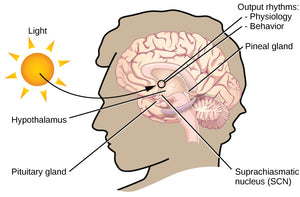Lateralisation and Split-Brain Research Revision & Quiz
Welcome to our A-Level Psychology Lateralisation and Split Brain Research Revision Quiz!
Are you studying the intriguing concepts of brain lateralisation and split brain research? If you're looking to assess your understanding of these topics and gauge your knowledge, you've come to the right place.
This quiz is specifically designed to test your comprehension of lateralisation, the specialization of functions in the brain's hemispheres, and split brain research, which explores the consequences of severed connections between the brain's hemispheres. By taking this quiz, you can evaluate your grasp of these fascinating areas of study and identify any areas that may require further revision.
So, get ready to challenge your knowledge, sharpen your understanding, and embark on an exciting exploration of the brain's complexities!
Before you take the quiz, here is a quick summary of what this topic is about:
Exploring the Wonders of Brain Lateralisation and Split-Brain Research
Have you ever wondered how our brains work and if the different halves have specific functions? Well, let's delve into the intriguing world of brain lateralisation and split-brain research.
Back in the 1800s, a French doctor named Marc Dax noticed something interesting while treating patients with speech difficulties. He discovered that all these patients had damage in the left hemisphere of their brains. This observation led Dax to suggest that language might be localised in the left hemisphere. Later, split-brain research allowed scientists to study each hemisphere independently by isolating them surgically.
Hemispheric Lateralisation
Our Unique Brain Halves: Our brains are fascinating organs, and they're not exactly the same on both sides. Each hemisphere of our brain has its own specialisations and functions. For instance, the left hemisphere tends to dominate in language and speech, while the right hemisphere excels in visual-motor tasks.
This knowledge was established by Paul Broca in 1861 when he found that damage to a specific area in the left hemisphere resulted in language deficits. However, a crucial question arises: If language resides in the left hemisphere, how do we talk about experiences that occur in the right hemisphere, such as recognising faces? The answer lies in the connection between the hemispheres through bundles of nerve fibres like the corpus callosum.
Unveiling the Secrets of Split-Brain Research
Split-brain patients, who have undergone surgery to sever the corpus callosum, provide a unique opportunity to study the abilities of each hemisphere.
Roger Sperry and Michael Gazzaniga were pioneers in exploring the capabilities of these patients. By presenting visual information to one hemisphere at a time, they investigated a phenomenon called hemispheric lateralisation.
For instance, if a picture of a dog was shown to the right visual field (processed by the left hemisphere), the patient could verbalise it. However, when a picture was shown to the left visual field (processed by the right hemisphere), the patient couldn't verbally acknowledge seeing it. These experiments revealed that each hemisphere has its own way of processing information.
Insights from Split-Brain Research
Split-brain research has uncovered several differences between the hemispheres. The left hemisphere has been identified as responsible for speech and language, while the right hemisphere excels in visual-spatial processing and facial recognition. It's important to note that this research hasn't confirmed that the brain is organised into specific regions with exclusive tasks. Instead, it highlights the significance of connectivity between different brain regions in performing various functions.
Examining the Advantages and Disadvantages of Lateralisation
Advantages of Hemispheric Lateralisation: Researchers have theorised that one advantage of brain lateralisation is increased neural processing capacity. By assigning specific tasks to one hemisphere, the other hemisphere is left free to engage in different functions simultaneously.
While there's limited empirical evidence supporting this assumption, studies on chickens have shown enhanced cognitive abilities when tasks demand the simultaneous but separate use of both hemispheres.
Lateralisation and Immune System Functioning: Architects and mathematically gifted individuals tend to have superior right-hemispheric skills. However, they also exhibit higher rates of left-handedness and immune system issues. Research suggests that the genetic processes involved in lateralisation may also influence immune system development, leading to a correlation between handedness and immune disorders.
Changes in Lateralisation with Age: Lateralisation of brain function doesn't remain static throughout an individual's lifetime. As people age, patterns of lateralisation tend to shift from unilateral to bilateral activation. For example, language becomes more lateralised to the left hemisphere during childhood and adolescence but decreases with each passing decade. This change may compensate for age-related declines in function by utilising the additional processing resources of the opposite hemisphere.
Evaluating Split-Brain Research
Language and the Right Hemisphere: Recent findings challenge earlier claims that the right hemisphere cannot handle even basic language functions. Studies have revealed cases where individuals could speak using the right hemisphere, demonstrating that language might not be restricted to the left hemisphere alone.
Limitations of Split-Brain Research: Due to the rarity of split-brain surgeries nowadays, researchers encounter a limited number of patients suitable for study. Small sample sizes have led to conclusions drawn from individuals with specific physical disorders or incomplete severing of the hemispheres. Identifying these outlier cases becomes crucial when replication of study results fails.
Conclusion
Brain lateralisation and split-brain research have unravelled some of the mysteries surrounding the unique abilities of each hemisphere.
Although the left hemisphere dominates language and the right hemisphere excels in visual-spatial tasks, the brain's interconnectedness plays a vital role in overall functionality. While split-brain research has its limitations, it has provided valuable insights into the organisation and processing capabilities of our remarkable brains.
Now, it's time to put your knowledge to the test! Take our quiz to see how well you've grasped the concepts of brain lateralization and split-brain research. Challenge yourself with questions that will assess your understanding of the different functions of each hemisphere and the insights gained from studying split-brain patients.




